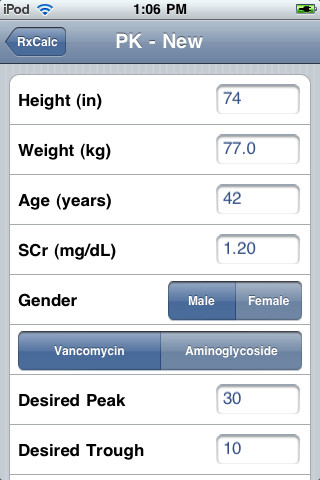 Pharmacokinetics is something that every hospital pharmacist is intimately familiar with. It just so happens to be one of the things that physicians routinely ask pharmacist to handle. It’s not that doing pharmacokinetic (PK) calculations is difficult, but crunching the numbers can be time consuming and there are occasional traps that can lead to problems for those not experienced in such things.
Pharmacokinetics is something that every hospital pharmacist is intimately familiar with. It just so happens to be one of the things that physicians routinely ask pharmacist to handle. It’s not that doing pharmacokinetic (PK) calculations is difficult, but crunching the numbers can be time consuming and there are occasional traps that can lead to problems for those not experienced in such things.
I’ve performed literally thousands of PK calculations* during my career. When I first began practicing pharmacy there were lots of drugs that required pharmacokinetic monitoring: lidocaine, procainamide, vancomycin, the aminoglycosides, phenytoin, digoxin, phenobarbital, among others. Over the years many of these drugs have been replaced by newer, better agents or simply fallen out of favor.
Some PK calculations can be harder than others, like phenytoin because of its reliance on Michaelis-Menten parameters, or lidocaine because it required loading doses due to its multi-compartment distribution. But others are brain-dead simple. Vancomycin is like that. A monkey could do a new vancomycin start.
During those years one thing remained constant; to perform PK calculations all you needed was a pencil and a calculator. Things have changed over the years with the increased use of computerized software and mobile devices, but the nuts and bolts of the process remains the same.
With the advent of big data one has to wonder why pharmacists continue to do this. Is it a matter of tradition that keeps us tied to pharmacokinetics? It’s hard to say. I remember looking at population trends when I was working as a critical care pharmacist nearly ten years ago. Another pharmacist, Patrick and I kept a spreadsheet of patient ages, gender, height, weight, renal function, infection site, infectious organism(s), and of course drug levels. We were attempting to use our data to find trends that would help us initiate therapy more accurately. Our project never really panned out. We discovered very little in the year we collected the information. The reason for our failure was lack of data and our inability to rigorously study the information in front of us. That’s no longer the case. Given the opportunity, data scientists could analyze hundreds of thousands of PK starts and adjustments to uncover things that Patrick and I could have only dreamt of a decade ago.
So one has to ask whether or not this is being done today, and if not why?
—————————————————-
*conservatively I see it as follows:
10 years as a “clinical pharmacistâ€
50 weeks per year working (hey, everyone needs a vacation)
average of 6-10 new PK starts per day; twice that number of monitoring
taking the low road: 10 x 50 x 6 = 3000
Leave a Reply